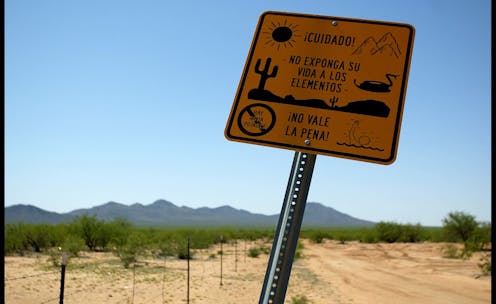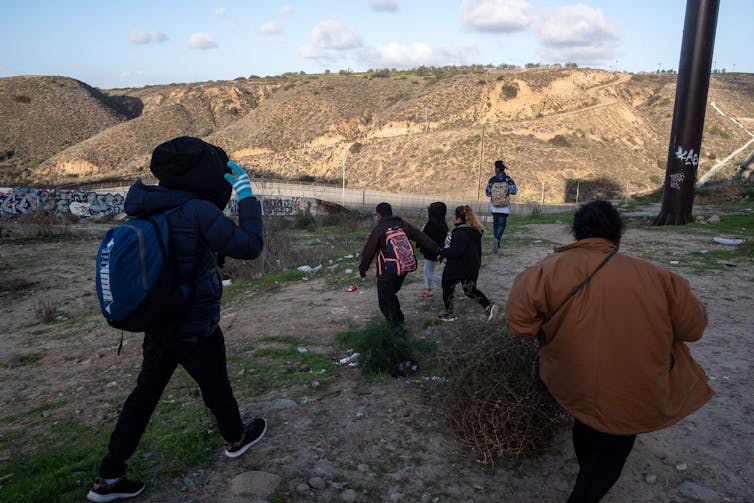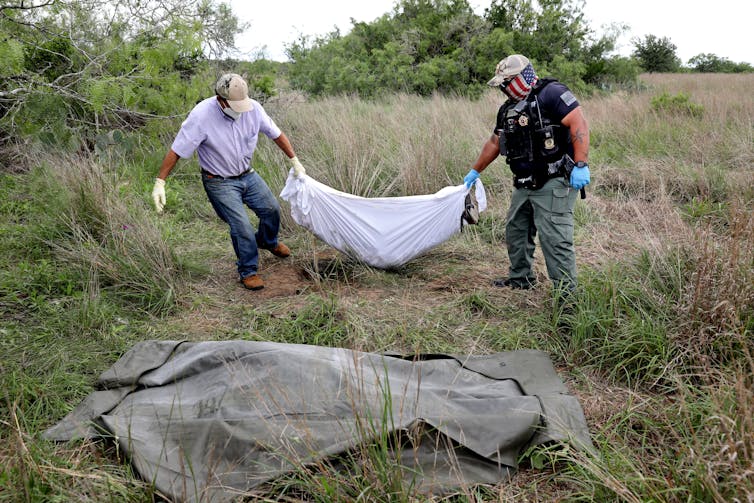
At least 650 migrants died crossing the U.S.-Mexico border in 2021, according to the International Organization for Migration, a United Nations agency that monitors migration.
The figure marks an all-time annual high since the U.S. government began reporting U.S.-Mexico border deaths in 1998.
U.S. Customs and Border Protection, which estimates migrant deaths over a slightly different time frame, reported that 557 migrants died along the border from October 2020 through September 2021.
But there is one important caveat to the new estimates.
The International Organization for Migration has noted that “all (migrant death) figures remain undercounts.”

Families left behind to ask questions
Currently a researcher and doctoral student in public health, I am also a licensed clinical social worker who works with immigrants, and I have spent years listening to people’s migration experiences. I understand the fear and desperation that drives people across the border and why it is difficult to know how many migrants actually die trying to reach the U.S.
Migration trends along the U.S.-Mexico border have recently shifted. A majority of people crossing the border are not from Mexico, having traveled instead from Guatemala, Honduras and El Salvador.
People migrate and attempt to cross the U.S.-Mexico border for complicated reasons, including violence and lack of work opportunities in their home countries.
But the journey across Central America and Mexico — or farther away, in some cases — is also rife with the potential of violence, including sexual assault and abduction.
Correctly counting migrant deaths matters. It can inform U.S. immigration and foreign policy, by determining whether the U.S. should send more aid to Central America to help stem migration flows, for example.
When migrants die crossing the border, it is often families who are left behind to ask questions and to tell their missing relatives’ stories. But sometimes immigrants’ fear of detention and deportation prevents them from talking to migration officials altogether.
‘An unprecedented militarization’
Over the past three decades, legislators have steadily increased the federal budget for border patrol enforcement activities along the nearly 2,000-mile stretch of arid land that makes up the U.S.-Mexico border.
U.S. border enforcement funding has increased from $1.935 billion in 1997 to $21.1 billion in 2018.
Working with Dr. Elizabeth Vaquera, sociologist and director of the GW Cisneros Hispanic Leadership Institute, we identified research showing that in 1997 there were 6,321 agents assigned to patrol the southwestern border. By 2011, more than 21,000 border patrol agents were stationed there. The number remained at nearly 17,000 from October 2019 through September 2020.
As border patrol presence has increased along the U.S.-Mexico border, migrants have adopted new travel routes, pushing them into more remote, treacherous parts of the desert. If border patrol agents apprehend migrants, they will detain and potentially deport them.
Once migrants stray deep into the Sonoran Desert or attempt to forge the Rio Grande River, though, they are much more likely to die than if they take more frequented routes. Exposure to extreme heat, cold, dehydration, venomous spiders or snakes, exhaustion and injury are all common risks.
Undercounting migrant deaths
Undercounting is not a new problem. But the likelihood of migrants’ bodies being recovered, and counted, has dropped as migrants travel along more desolate paths. Migrant bodies have been discovered in increasingly remote areas, farther from roads, towns and cellphone service, since 1990.
The U.S. Centers for Disease Control and Prevention tracks deaths in the U.S. But there is no U.S. government agency devoted to tracking migrant deaths, even if they happen on U.S. soil.
U.S. Customs and Border Patrol reports border crossing deaths, but only if border patrol agents recover the bodies.
This leaves bodies recovered by other law enforcement agencies, humanitarian groups, or private citizens unaccounted for, and often unidentified.

A rise in migrant deaths
While the number of migrants apprehended along the U.S.-Mexico border has continued to decrease since the mid-2000s, the number of recorded deaths has continued to rise.
Although Customs and Border Protection acknowledges an increase in migrant deaths over the past few years, investigative findings by USA Today in 2017 suggested that the problem may be much worse.
The number of migrant deaths along the U.S.-Mexico border may have been anywhere from 25% to 300% higher than official totals from 2012-2016, the USA Today investigation found.
Nonprofit humanitarian organizations like the South Texas Human Rights Center and Humane Borders provide information on search and rescue operations for missing migrants and use data to map deceased migrants.
But these groups’ staffing and funding are not sufficient to comprehensively track migrant deaths and cannot replace the work of a government agency responsible for tracking this ongoing problem.
The authors do not work for, consult, own shares in or receive funding from any company or organization that would benefit from this article, and have disclosed no relevant affiliations beyond their academic appointment.
This article was originally published on The Conversation. Read the original article.







